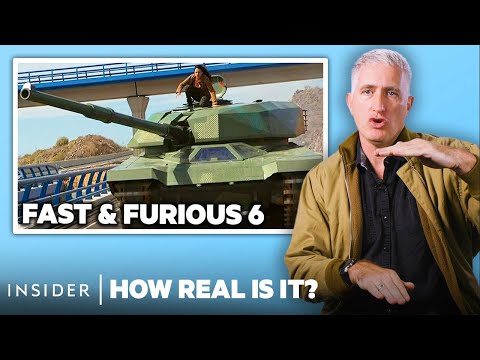Military Tank Expert Rates 8 Tank Battles In Movies And TV | How Real Is It? | Insider

Driving through a building looks awesome. In reality, though, tankers hate going through buildings. In one word, it's basements. Greetings, all. I'm Nicholas Moran.
I commissioned as an armor officer on M1 tanks and then M3 Bradleys. These days, I work as a civilian historian for the publisher of World of Tanks. Today, we're going to be looking at tank battle scenes in movies and television and judging how real they are. This is absolutely correct. There's gun crews on each side of the sponson. The tank is based off of a Mark VIII "International," which was a very late World War I tank built by both the UK and US.
And at the time, British tanks, the heavy tanks, had what were called sponson guns, the turret that wasn't on the Mark VIII. [shouting instructions] Shouting instructions to each other wouldn't happen. It's too loud. Inside a World War I tank, the entire middle of that tank was taken up by the engine. It was massive noise. What he's doing there, he's using hand signals.
That's the only way to communicate inside a World War I tank. Firing a gun with anything in the barrel is bad. You run the risk of exactly what happened here. It's called petaling, when the gun barrel just petals out like a flower. And your gun is done. Oftentimes, you'll see a tank will have a rubber muzzle cap on the end, purely to stop any dirt at all from getting into it.
And it's designed that you can actually shoot through the muzzle cap. To my knowledge, on-tank fighting has never been trained in any army. Personally, I'd have just stuck my head out the top, used a pistol. But, again, not very dramatic, and it would kind of suck for Indy. I would have to give this scene maybe a 3 on feasibility grounds.
A Tiger has appeared on the scene. Tiger had a mythical status in World War II. It had the reputation because it was very, very hard to kill and because it had a heck of a gun.
The 8.8 centimeter was lethal to basically everything. The problem was that it looks very much like a Panzer IV, which was a lot more common. In actuality, historians have found very few times on the Western front that American soldiers ever actually met a Tiger. But for the purposes of drama, a Tiger is fine.
This was pretty realistic. Drivers are absolutely blind inside their tanks, and they're utterly reliant on instructions from the commander. So, that's how you would get up close to a tank. Low, below the line of vision, below the level of depression that the guns can aim at you.
We're going for the wheels. Because the Tiger was a breakthrough tank, it was heavily armored everywhere. And if you are infantry and you don't have high-velocity cannons, your best bet is to disable the tank and get what's called a mobility kill to immobilize the tank.
Your two choices are going to be either the engine compartment or the running gear. And the only thing that these sticky bombs are going to have any particular effect on will be the running gear. So, the sticky bomb, it was in the manual, but it is also almost a weapon of desperation. The military is supposed to give you tools for the job. Late World War II era, you're talking about the bazooka.
Now, the problem is that you only have so many rounds of bazooka ammunition, and a bazooka is only so effective against something as heavily armored as a Tiger. So you're in desperation mode to start with. Soldier: Both sides, get aboard! Get a grenade! So, now we see one of the problems with a tank going on its own.
A tank shouldn't go on its own for several reasons. But when you have infantry, an infestation, we might like to say as tankers, crawling on your tank, there's a process that's called "scratching your friend's back." What you do is you get on the radio, you call your buddy with a machine gun, and he will machine-gun your tank. Of course, the bullets aren't going to affect your tank. You're in a tank. But it will very much clean off
or delouse the infantry that are crawling on your tank. And that's your example of delousing. So, the 20-millimeter anti-aircraft gun, like any anti-aircraft gun with a high rate of fire, you aim that thing horizontally and you will do a number on infantry. If there's any big myth about tanks, it's probably that they are these invulnerable fortresses. In reality, they're not invulnerable at all, and they're absolutely reliant on the other parts of the combined arms team. You have the desperation of lightly armed infantry.
You have this back-scratching. You have the immobilization of a very dangerous tank. I mean, this is easily on the 9 scale. And that is absolutely accurate. The vast majority of tanks that were destroyed had no idea that the enemy was there. And, again, this is why you always have to work in conjunction with infantry, because they have more eyes than you do.
They have better vision than you do. But more often than not, the first indication that somebody is there is when you get shot at. And knocking off either the first or the last tank in an ambush in a row like that is classic. What the f--- was it? That was an 88. It's a goddamn tank. With regard to the TCs in this case keeping their heads out, there are two schools of thought. But certainly in the time period of World War II all the way through the Cold War, even myself, it would be in a head-out position.
The Western school of thought is you keep your head out because what you don't see will kill you. The other school of thought, such as used by the Soviet Army in the Cold War, was that you wanted to operate head-down. So you close the hatch, no artillery could affect you, no snipers could affect you. And the problem, of course, is the reverse.
You aren't able to see whatever is about to kill you. So there is a balance to be struck. All right, all tanks, move forward.
Wardaddy has decided for some reason that he's going to charge the enemy tank. I'm not sure I would've done quite the same thing, because that simplifies the problem for the enemy and just gives them three targets in a line. If you can have what's called a base of fire and then a maneuver element, then the enemy tank has a choice.
It can engage the guy that's just sitting there pumping accurate shots at you, or the German tank can engage the flanking element, who are coming around the side. And the 76-millimeter gun on two of these tanks actually would destroy a Tiger. OK, so, being obscured, the German tank has decided to advance out of the smoke as opposed to just sit there and wait for whatever the enemy were going to do.
The Germans were very, very big on individual initiative. The concept is called auftragstaktik. These days, we use a development of it called mission command. But the bottom line is you don't wait for orders. You take the initiative. You make a decision on the spot.
And that is exactly what the German has done here. Wardaddy: Bible, put it up his a-- while the armor's thin. I know it'll f---ing hit him! The reticle is accurate for a World War II American tank, and Shia, in this case, is using the coaxial telescope. So you're going to see graduations on the reticle.
Each graduation is for a type of round at a certain range. So if your target is, let's say, 800 yards, you will elevate the gun so that the 800-yard graduation is on the target. So, the single biggest cause of missing in World War II was range-estimation error. If you get the range wrong, it doesn't matter if your aim is correct, you will go over or short, which is why we now have modern fire-control systems to do all that mathematics for you. Again! On the way! If you are in this sort of a knife fight, which I wouldn't recommend getting into, the first round set the engine alight, but that doesn't necessarily say that the tank crew in the turret can't still get a shot off. They say you shoot at a tank until it burns or changes shape.
So keep shooting until you know that the threat is gone. This scene is an easy 9. What "Fury" lacks in perhaps some of the technical accuracy, it more than makes up for in understanding the experience of being a tank crewman. Tanks don't go from 0 to 60 just like that. They're not sports cars. But they look a lot faster than they're actually going.
By way of comparison, the M1 will do 0 to 20 miles an hour in somewhere over seven seconds. So to be launched like that, you are relying a lot on the momentum of the truck itself. But, hey, it's a 60-something-ton tank. It has a lot of momentum. This is obviously a derivative of some sort of futuristic tank.
In reality, it's a 1960s Chieftain that they've dressed up. But one of the problems you see with this tank is you have the big glass windows for the driver. In reality, you don't want to have big glass windows on a tank, because it's a weak spot. Guys, we gotta come up with another plan. They got a tank.
If the opposition comes up with a tank and you don't have anything that's an antitank weapon, yes, you are in a serious problem. All you can do is try to be faster than it, evade it, move to where it can't see you. If it can see you, it can probably shoot you.
The tank is not going to slow down because of the massive recoil of the gun. Modern tanks have what's called stabilization, and what it's designed to do is to keep the gun on target. So, with this in mind, tanks are now very capable of firing on the move. My initial thought is to give it something like a 3, because, yes, tanks are scary, tanks will run over anything that they come across, but the general concept of this high-speed chase is just not there. So, that's Pierce sticking his head out a little bit too much.
If you're trying to drive a tank, remember, you do have pedals, or usually the brake or the accelerator, and you've got to be able to be low enough to reach them. So, a tank driver's seat has two positions, up or down. So head out when you are not in combat, when nobody's shooting at you. You can see a lot better.
Because when you're driving head-down with the hatch closed, through a little periscope, it's very easy to miss things, and you run over people that you don't want to run over. The very, very latest tanks do have cameras rotated around, but oftentimes they don't. Tanks are actually very, very easy to drive. So, inherently, a tank is designed to be as simple as possible to operate, especially for a Soviet tank. If you can drive a car, you can basically drive a tank.
Some pretty cool drifting there. If you are going to drift in a tank, you either want ice or you want a Soviet track. So, there are two types of track you can get on a tank, generally speaking: rubber track or all-steel track. And Soviet tanks tended to go with an all-steel system. Although the metal grousers are great for digging into dirt and mud and getting you some excellent cross-country traction, on a road, there's very little contact area between the track and the tarmacadam. So what you're doing is you're just sliding, quite literally sliding around.
So that drifting was kind of fortunate that they had a Soviet tank doing this. So, a tank driving through a building looks awesome. In reality, though, tankers hate going through buildings.
If there's any one reason that tankers hate going through buildings, in one word, it's basements. Because if you think about it, your typical house structure is not designed to hold the weight of a 40-something-ton vehicle above a basement. And oftentimes, there is no indication before you drive through the building whether or not there is a basement under you or solid ground.
In this case, it would appear that he has gotten lucky. I would probably put it down more on the 5 area. He is in a vehicle.
All right, it's a black ... tank. The definition of what is a tank is somewhat debated. The traditional definition often revolves around the physical characteristics. It's going to have tracks, it's going to have a gun, it's going to have a turret, and it's going to have armor.
But that could also be used to describe a self-propelled artillery piece. It could be used to describe an infantry fighting vehicle. And it cannot be used to describe the very first tanks, which had no turret, or the S-tank, the Swedish tank, which also had no turret.
So, these days, you're probably better off defining a tank by its role. It's a way of getting a gun from A to B, and it's very difficult to kill. So, the Tumbler here at least has armor and mobility. Oh, it does have a gun, OK. I see absolutely no practical reason why he needs to move to a new driver's position in order to operate this feature of the vehicle. Having the room inside this vehicle to move from one position to an entirely new position, it's bad design, because you want to have, that empty space needs to be protected by armor.
That larger amount of armor weighs more. And that gives you flotation problems, emphasizing the problem you have now on a wheeled vehicle of this extra weight coming down on a set of wheels. Wheeled vehicles don't have the advantage of the tracks. You spread the weight of a 60-odd-ton tank onto a piece of dirt or mud that it doesn't sink into it. We do have an impression perhaps as to just how light this vehicle is, because he is now driving on a roof. Roofs are not usually designed to hold armored vehicles on top of them, which also means all this vehicle will do is stop perhaps machine-gun rounds, and it's not going to stop a rocket-propelled grenade or an antitank round. As for the vehicle itself,
I don't think that there is any actual equivalent in military service around the world. The closest might be for something like a reconnaissance vehicle. So, there is a vehicle called the Fennek, and that is, in appearance, very similar.
It's sort of an angled four-by-four, and it's designed to be fairly fast, fairly low-profile, to sneak around the battlefield and do reconnaissance. For what it is, I'll give it a 7. The tanks that they're using are also very good vismods, a visual modification. What we have here is an earlier version of today's American tank, the M1 Abrams, and it's basically the version that I was on when I was in Iraq. For a moment, I was in disbelief that they had used actual M1s, because the M1 has a jet engine.
It has an extremely distinctive sound. [engine whirring] And in this movie, you hear the engine starting, and the sound designers put in the turbine engine, and that was enough pause that you realize, are they Abrams? So what they've done is they've taken British Centurions, they've made it into an M1. So, real tanks don't drive that close. You're going to have 100 or 200 yards in between tanks, because if you're that close, you make yourself a perfect target for artillery or aircraft or anything else with a blast radius. Why give the enemy an easy shot? The idea of this battle happening at night is absolutely in line with American doctrine of the time. Set in the 1991 Gulf War, commonly known as Desert Storm.
The US in particular owned the night. With modern night-vision gear, it cannot be understated the advantage that these pieces of equipment would give over their enemy, who could not see or fight at night. The most famous of the '91 battles like this was called 73 Easting. A swarm of tanks coming at you, firing on the move, at night. You can't see them. All you know is that there is explosions and your own tanks are blowing up.
And it was absolute textbook shock attack, and it has become one of the most famous battles in US Armor Branch history ever since. So, what he's holding there is, I believe it's a PVS-7. It's an earlier version of an image intensifier that we'd use even today.
On these earlier M1 tanks, the commander's handheld vision is not as good as a thermal imager. All right, baby. Hold on, son. They got no range. The commander has dropped down.
He's now looking through what's called the gunner's primary sight extension, and this allows him to see exactly what the gunner is looking at. Calm down. Calm down, son. Find me another target. Loaded. - Identify. - Up! - Fire! - On the way. So, the coordination in here is perfectly reasonable.
The crew of the M1 is the driver, loader, gunner, and commander. The commander confirms the target. He gives the fire command. The loader loads the round, arms the gun, yells "up." He keeps back out of the way because he doesn't want to get hit by that 120 as it comes back to him. Cease fire, cease fire.
It's absolutely reasonable that there would've been personnel outside of the hatches shooting machine guns if they had to get that close. Now, ordinarily, you wouldn't want to get that close. You'd actually stop, and you will let the infantry that you were supposed to be operating with, the last 100 yards, while the tanks provide the overwatching support. Fire! You just lit up a friendly. I heard you. We -- what?
Oh, my God. You just lit up Boylar, godd--- it! So, he has just fired and engaged a friendly tank. It's called, in army speak, a blue on blue. Now, friendly fire has been a problem since day one of ranged combat.
The problem that you had with the M1, especially with the early thermal imagers, was that it was much, much better at spotting targets than it was at identifying them. And at a long range or if surrounded by fire, such as it is here, you didn't always know for sure what it was that you were engaging. And the other problem is that friendly fire has become a lot more of a thing. Because recent combat has been so lopsided, that if the enemy kills one of your guys, you know it. They will have to live with the effects of they have just killed their friends, which is exactly the premise of the movie here. So, I'd have to give them a 9.
Overall, the tank battle scene in "Courage Under Fire" are excellent. Let's go. All right, move on. Every tanker I know wants to be Oddball secretly, and I'm guilty of that too.
We tried hooking up a loudspeaker to our tank once to play music. It didn't work out, unfortunately. Oddball: Fire. OK, so Oddball has fired a paint round. Such things do not exist, but Oddball is Oddball. What he has done, though, given the situation that Kelly and Oddball were in, that's pretty much how I'd do it.
If you're going to shoot at a Tiger, the rear is the place you're going to do it. If I was the German tanker, I probably would not have gone down this road in the first place. Tanks rule in open area like deserts.
In urban areas and in dense forests, infantry rule, and this is part of the reason why. Since you can't see the corners like you can in a car, you are reliant on somebody on the outside telling you which way to go forwards, backwards, left, or right. This is a sort of situation where you need infantry. Subject to minor details, like a tank which fires paint rounds, has a large loudspeaker on the side to play morale-boosting music, that's actually a pretty good scene. So I'd give that maybe an 8. Another mandatory movie for tankers.
My favorite tank movie? Well ... very, very difficult, because it's a three-way fight. Two of them we've seen here: "Fury" and "Kelly's Heroes." The third one that I'd call out is "The Beast," which is from the 1980s.
It's about a Soviet tank crew lost in Afghanistan. Thanks for watching. If you enjoyed this, why not click on the video above?
2022-08-02 19:36


